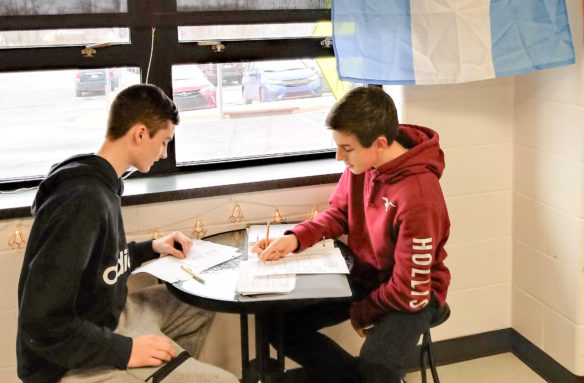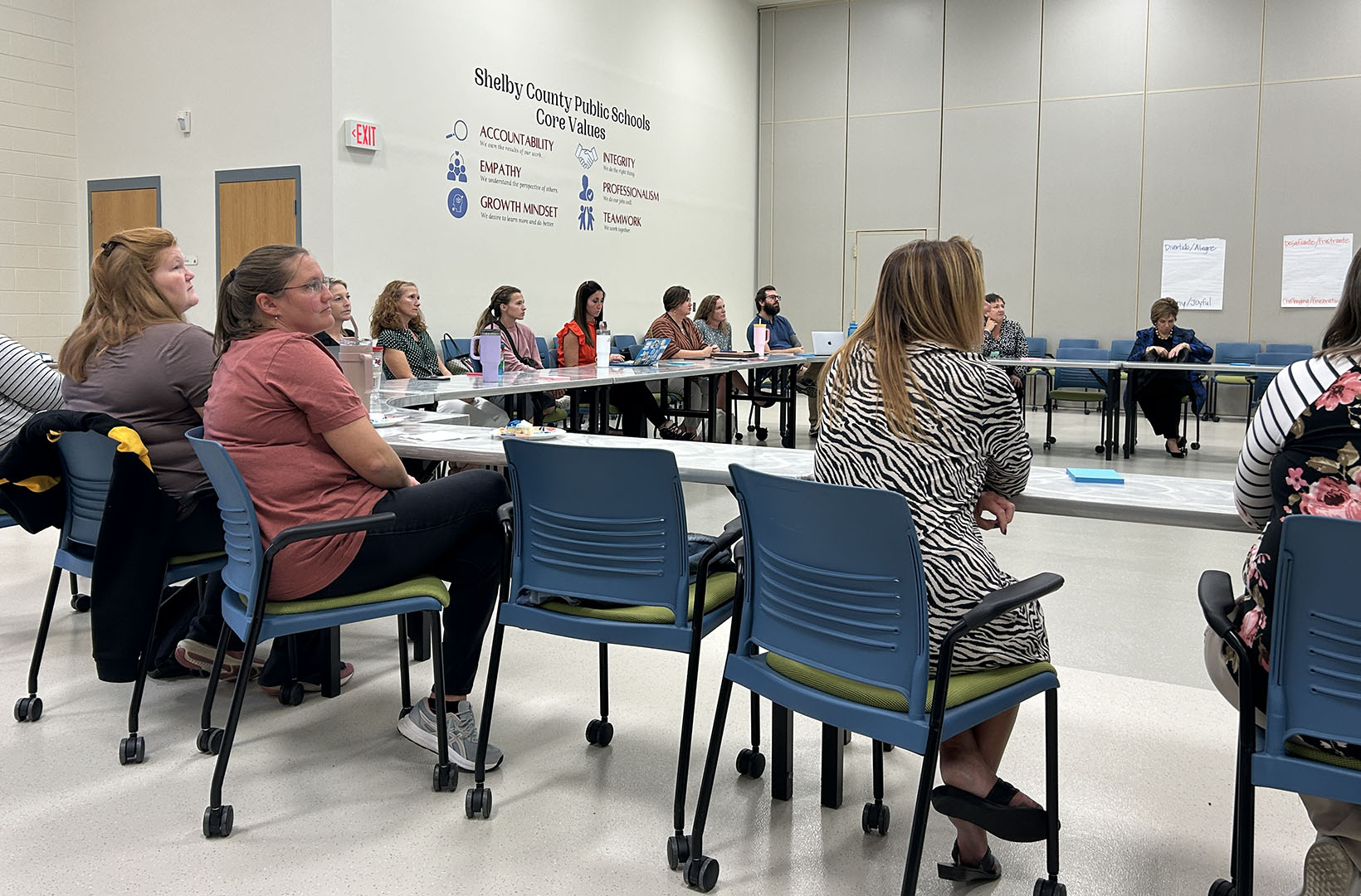
Alexander Baker, left, and Elliott Herzog speak Spanish in the Linguacafé in their classroom at Walton-Verona High School. The second core practice described in a series of articles in Kentucky Teacher explains how to incorporate more interpersonal communication into your classroom design.
Submitted photo by Alaina Post
By Alaina Post
alaina.post@wv.kyschools.us
At your hiring interview to become a world language teacher, you were probably asked how you imagine your classroom. You probably described it as “buzzing with language,” or maybe you said that your students would be “engaged in the target language.”
Regardless of your answer, did your fantasy align with reality? It has taken me many years, but finally, mine does!
Teachers are always telling students to re-evaluate their work, redo this assignment, correct your mistakes, think about that and try again. What if teachers were made to do this more? No matter how many years of experience you have, it takes a lot of practice, reflection and repeated attempts to become the teacher you dream of.
So how do I get my students to be engaged, motivated, confident to speak and excited about the target language? I do six things, and I keep making sure to reflect upon my teaching every day. I ask myself a series of questions and make sure I follow through with the answers.
Last year, the Kentucky World Language Association (KWLA) commissioned several leaders in world language learning to write a series of articles for Kentucky Teacher highlighting the six core practices in Eileen Glisan’s “The Teacher’s Handbook.” These practices are designed to help world language teachers provide their students with a pathway to proficiency.
I used the practices explained in the KWLA series to reflect upon my teaching regularly. I also have used the articles as professional training for a new colleague. Last summer, when my school hired a new teacher, the first thing I thought of to orient her with the proficiency-based teaching at our school was this series. And because Kentucky lacks funding for world language professional development, I am suggesting using the core practice series as a sort of self-serve professional development course for teachers.
I invite you to use the information presented here as a guide to determine which core practice articles will best serve you and your departments. In the following sections, I will provide examples of what I have asked myself that led me to look for the answers that are now easily accessible in the core practice articles. I also have compiled a quick guide with links to the original content published last year on Kentucky Teacher.
As you read the summaries, keep these reflection questions in mind:
- How am I currently addressing this in my classroom?
- What are examples of this practice given by the language leader?
- Which of these practices would fit easily into my curriculum?
- What is one practice mentioned that I like/could see myself implementing?
- How can I implement this practice?
- What support do I need from my department or administration?
- What resources do I need?
- What questions do I have?
How much target language should I be speaking? What about the students?
Core Practice 1, explained by Sara Merideth, former president of KWLA and current French teacher in Lexington, is titled “Using the target language as the vehicle and content of instruction.” The American Council on the Teaching of Foreign Languages (ACTFL) recommends that 90 percent of class time be spent in the target language. As Merideth points out, this practice is often the most difficult for world language teachers of any level to achieve. The way Merideth writes the article, however, is not to shame any teacher, but to support them and remind them why this practice, above all others, will foster the most growth in our students on their journey to proficiency.
How do I get students to produce meaningful output in the target language?
Nicole Naditz, former winner of the ACTFL National Language Teacher of the Year and current French teacher and language learning leader in Sacramento, Calif., penned the next core practice article titled “Fostering interpersonal communication.” If Merideth’s article is the why, then Naditz provides the how. If world language teachers at any level are struggling to implement interpersonal communication into their classroom or are just in a rut, then this article is a must-read.
The suggested 90 percent target language communication is not only on the teacher’s shoulders, but also should be evident in the students’ language output during class as well. In fact, you can often tell as a world language teacher if you are using the target language enough by how much output you hear from your students. Naditz’s article is a great resource for ways to incorporate more interpersonal communication activities into your instruction.
I only see my students for 50 minutes! How do I plan my lessons and units to incorporate all this?
The next article in the series is probably the next question on any world language teacher’s mind after reading the previous articles – how to implement these practices. Kathy Shelton is the world language education program specialist at the Ohio Department of Education and is a member of several committees and task forces that offer professional development training to teachers. In her piece, “Backward design of world language curriculum,” she not only provides a guide to unit planning, but also what I would call an essential, comprehensive guide to instructional planning for world language teachers.
Shelton also uses her piece as a vehicle to make the case for transitioning your world language program to a proficiency-based one, and reminds readers that the resources provided are all designed with that type of program in mind. Therefore, world language teachers, administrators, curriculum planners, and even school board or site-based council members may have interest in this article to inform themselves on how their school would benefit from a proficiency-based language program.
How do I teach grammar?
Lisa Harris is a 25-year veteran and current specialist for foreign languages and international education at the Virginia Department of Education and executive treasurer of the National Council of State Supervisors for Languages. Harris deals with this controversial topic of how to teach grammar by presenting facts from research. Her article, “Teach grammar as a concept and use it in context,” shows us the evidence for implicit grammar instruction, how it facilitates language proficiency and how it can be done in a classroom setting.
What are authentic resources and how do I use them?
Dorie Conlon Perugini writes the fifth core practice article in the series, “Using authentic texts and resources.” Perugini, an elementary Spanish teacher in Connecticut and executive secretary of the National Network for Early Language Learning, also writes her own blog, “A Global Classroom.”
In her piece, she dispels the common misconception of world language teachers that authentic resources are only for higher-level language learners. She shows how to make resources work for any level of learner, even the novice. This is a must-read for all language teachers, especially if you have been in the classroom since before the internet.
How do I help students correct errors without making them afraid to speak?
Lea Graner Kennedy holds many titles, but two of those are world language coordinator for Stonington Public Schools in Connecticut and president of the Connecticut Council of Language Teachers. She wrote how to “Provide feedback to improve learner performance.”
Since learning how to speak a world language is oftentimes frightening for a student, being corrected can sometimes completely break them down. Therefore, Kennedy points out the different types of correction, when they are appropriate and how to deliver them to help – rather than hinder – a student’s performance.
The KWLA world language core practices series is an essential read for all world language teachers, whether they are first year or veteran educators. I have had to revisit certain articles in the series several times for a refresher or for inspiration after a tough day.
Each article presents extra resources and contact information so professional learning can be tailored to each teacher and/or department. If you would like more resources or have questions, do not hesitate to contact the authors of the articles, your regional KWLA representatives or the Kentucky Department of Education World Language Consultant Alfonso de Torres-Nuñez.
Alaina Post is the Spanish teacher at Walton-Verona High School and head of the World Language Department.



Leave A Comment